PREVIOUS
Chandrayaan Missions of India – Part 2
August 28 , 2023
599 days
2231
0
(இதன் தமிழ் வடிவத்திற்கு இங்கே கொடுக்கவும்)
Chandrayaan 2
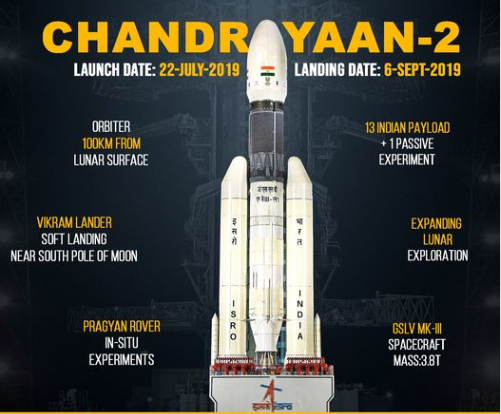
- Chandrayaan – 2 is the second lunar mission of India after the success of Chandrayaan 1.
- Chandrayaan-2 is India’s first Lander mission.
- This mission was conducted for topographical researches and mineralogical studies to have a better understanding of the Moon’s origin and evolution.
- It consists of an Orbiter, Lander and Rover.
- It is all equipped with scientific instruments to study the moon.
- The Lander and Rover modules will separate from the orbiter.
- It is makes a soft-landing on moon’s surface (either on September 5 or 6, 2019).
- The Lander and rover are designed to work for only 14 days (1 lunar day).
- While the orbiter would remain in orbit for a year.
Chandrayaan-2: Design and Mission Profile
Orbiter
- The Orbiter would once again watch the moon from a 100-km orbit.
- The Orbiter is a 2379-kg spacecraft with 7 instruments on board.
- It is equipped with different kinds of cameras to take high-resolution three-dimensional maps of the surface.
- It also has instruments to study the mineral composition on the moon.
- It is to assess the lunar atmosphere and to the abundance of water.
- The Orbiter will observe lunar surface.
- It is to relay communication between Earth and the Lander.
Lander
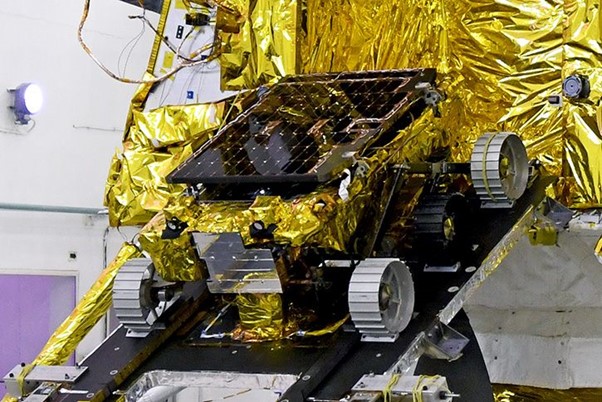
- ISRO has named the Lander module as Vikram, after Vikram Sarabhai.
- He was the pioneer of India’s space programme.
- The 1471-kg lander will remain stationary after touching down on the moon’s surface.
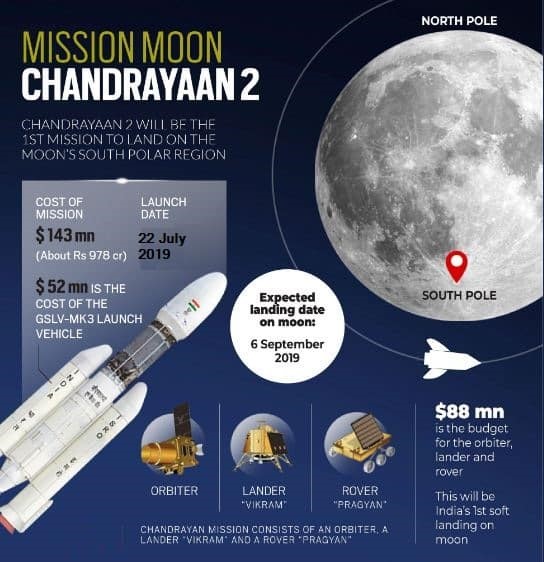
- It will carry three instruments that will mainly study the moon’s atmosphere.
- One of the instruments will also look out for seismic activity on lunar surface.
Rover
- The Rover is a 6-wheeled, Artificial Intelligence-powered.
- It is solar-powered vehicle named Pragyan.
- Pragyan means wisdom.
- Once on the moon, the rover will detach itself from the Lander.
- Equipped with two instruments, it would slowly crawl on the surface.
- It is making observations and collecting data.
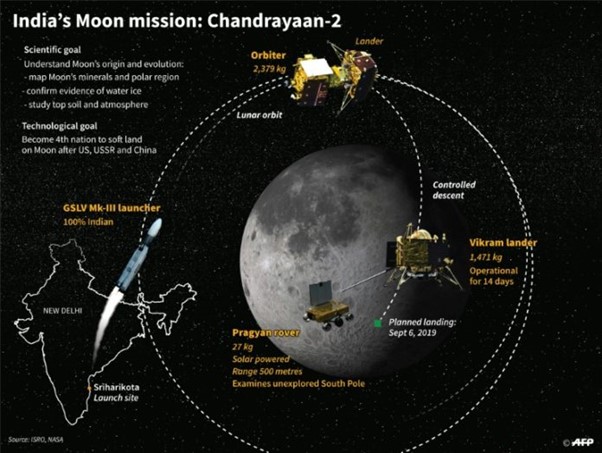
- Its primary objective is to study the composition of the moon’s surface near the landing site.
- It would also determine the abundance of different elements on the moon’s surface.
- It was planned to land on the South Pole of the Moon, Chandrayaan-2.
- It was launched on 22th July in 2019.
- However, the lander Vikram hard-landed on 7th September 2019.
- ISRO recently announced the launch date (July 15, 2019) of Chandrayaan-3 mission.
- It was after the long delay from the scheduled launch.
- All of the above parts were developed in India.
- The orbiter, lander and rover collectively carried 14 scientific payloads.
- It was including a Laser Retro Reflector Array from NASA that provided precise measurements of the distance between the Moon and the Earth.
What are Chandrayaan-2’s features?
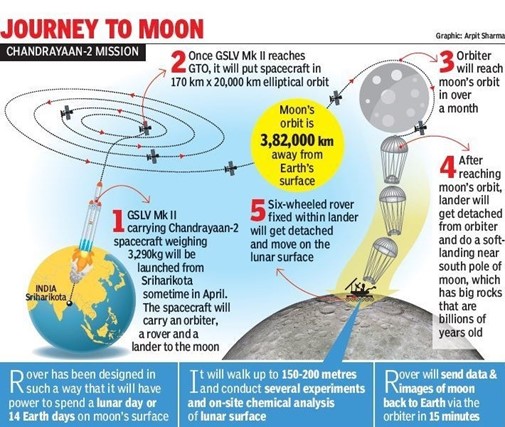
- The same kind of information was also obtained by NASA's Deep Impact-EPOXI mission.
- EPOXI mission passed near the Moon in June 2009.
- On 22 July 2019, India launched Chandrayaan-2.
- It is second lunar exploration mission after Chandrayaan-1 from Satish Dhawan Space Centre, Sriharikota.
- It is a Lunar orbiter, lander, rover type mission.
- It is expected to do soft-landing on the Moon on 7 September, 2019.
- Chandrayaan-2 is ISRO’s first attempt to land on any extraterrestrial surface.
Core Objective
- It aims to map the location, and abundance of lunar water.
Background
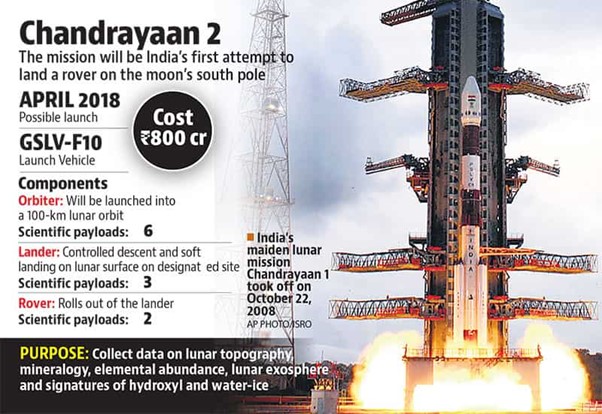
- The project began in 2007 with an agreement between India’s space agency ISRO and Russia’s ROSCOSMOS for mutual cooperation.
- However, the mission was postponed in January 2013.
- It was rescheduled to 2016 as Russia was unable to develop the lander on time.
- Later, after Russia’s withdrawal, India decided to develop the lunar mission independently.
- Finally, on 22 July 2019, GSLV MK III M1 on its first operational flight successfully launched Chandrayaan-2.
- Once successful, India will become the fourth country to soft-land a spacecraft on the Moon after the USSR, the USA and China.
- Chandrayaan-2 will make a landing at a site where no earlier mission has gone.
- It will be near the south pole of the Moon.
- Chandrayaan-2 is a natural sequel to Chandrayaan-1.
- It was an Orbiter mission launched in October 2008.
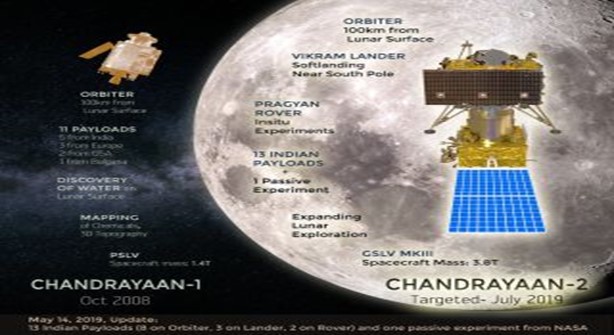
Mission Objectives
- India wanted to study the southern pole of the lunar surface.
- No country in the world has ever launched its spacecraft on the southern side of the Moon.
- The main objectives of the mission were as follows:
- To find the existence of water and the Hydroxyl group.
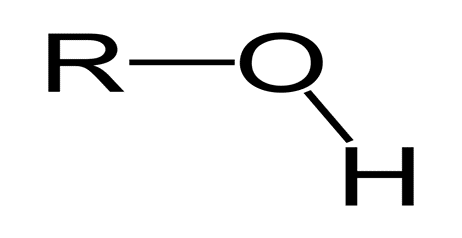
- To study the topology and exosphere of the Moon.
- To study the mineralogy, surface chemical structure, the lunar atmosphere.
- To study the origin and evolution of the Moon and thermo-physical elements.
- To Create a three-dimensional (3D) map of the lunar surface.
- To Try and build on the evidence of water molecules shown by Chandrayaan-I.
- To study the extent and distribution of water on the Moon
- To study the ancient rocks and craters.
- The Chandrayaan 2 components were designed to measure the thickness of the lunar regolith.
- India independently designed all the Chandrayaan 2 components.
- It wanted to experiment with soft landing on the lunar surface.
- It can offer indications of origin and evolution of the Moon.
- The South Pole region of the Moon also contains clues to the fossil records of early solar system.
- Thus, it will improve our understanding of the early solar system.
- It will Map the lunar surface and prepare 3D maps of it.

Mission Challenges
- Chandrayaan 2 is a technologically challenging mission.
- It requires the multifaceted developments of various new systems for the first time.
- The Lander is the distinguishing feature.
- As it is the first time that ISRO is attempting to soft-land a module in extra-terrestrial space.
- Once the Lander and the Rover, enter the Moon’s gravity, they would be in a state of free fall.
- That could end in crash-landing and destruction of instrument.
- The main challenge is thus in controlling its speed as it approaches the surface.
- To enable a smooth landing, the speed of the Lander just ahead of touchdown should be 1 m/s (3.6 km/h) or less.
- Due to lack of air to provide drag, these instruments cannot make use of parachute-like technologies.
- So instead, the Lander fires thrusters in the opposite direction to slow down.
- It requires a very high level of perfection.
Major challenges in the complete mission involve:
- Successfully performing the launch of its heaviest rocket GSLV-Mark III.
- Ensuring trajectory accuracy while travelling such a long distance.
- It will perform successive orbital manoeuvres to raise the module into higher orbits.
- It will perform Until it reaches the “Earth to Moon” transfer orbit.
Landing on safe hazard free zone
- ISRO had never performed soft landing on any space object.
- The lunar surface is covered with craters, rocks, dust, hot gases.
- It faces extreme surface temperature variations.
- Thus, it is an extremely hostile environment for Lander and rover operations.
- Further, the South Pole region of the Moon receives less sunlight compared to equatorial region.
- The equatorial region is required by solar-powered instruments.
- Thus, the margin of error is extremely narrow.
- The recent failure of Israel’s Moon landing mission indicates the difficulty in soft and precise moon landing.
Leave a Reply
Your Comment is awaiting moderation.


